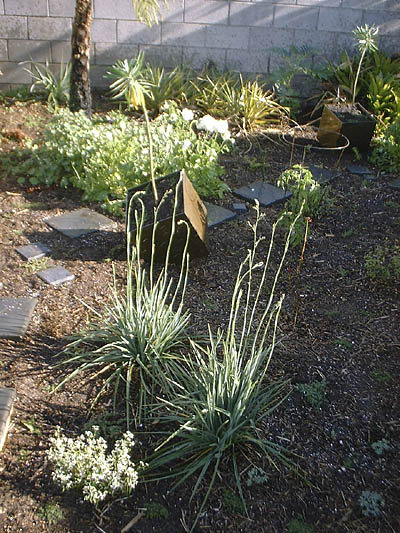This is the result of one of my weekend projects:
 It’s one of four steel cubes that I assembled to put in the new raised bed. The sides of the bed are made of sheet steel that’s already weathered to a rich, warm, rusty patina, so I wanted some pots to put in it that were of the same material.
It’s one of four steel cubes that I assembled to put in the new raised bed. The sides of the bed are made of sheet steel that’s already weathered to a rich, warm, rusty patina, so I wanted some pots to put in it that were of the same material.
John vetoed my first avant-garde conceptual ideas for arrangements, arrangements that worked with competing systems of geometrical hierarchies, one of them based in part on some of the ideas behind Bernard Tschumi’s postmodernist and highly conceptual Parc de la Villette in Paris. But below is one that I finally came up with that makes us both happy. It has some of the geometrical tensions that I wanted to work with. At the same time, the arrangement of the elements is a little chaotic and whimsical–to the point that none of them sit flat on the ground–a quality that appealed to John.
Each pot is planted with the identical plant material. Euphorbia lambii is placed in the center, pointing as perfectly upright and away from the earth’s core as I could manage without getting out the level, an effect that I’m hoping will point out how crookedly each planter is placed. Creeping thyme will eventually protect the top of the slanted top plane of potting mix.
This is an overview of two of the other containers in the garden space, here in the middle- and background, with part of the new stepping stone pathway:
 If you have basic of welding chops and a supplier that will pre-cut pieces fairly accurately, you can make them yourself in an afternoon. You could also make similar containers by screwing the steel plate to little pieces of angle iron. Part 2 of this post provides some basic instructions for the welded version shown here.
If you have basic of welding chops and a supplier that will pre-cut pieces fairly accurately, you can make them yourself in an afternoon. You could also make similar containers by screwing the steel plate to little pieces of angle iron. Part 2 of this post provides some basic instructions for the welded version shown here.

I love your “musings” and use them for inspiration in my own garden. I’m trying a steel veggie bed right now. I wondered if you found the sheet insulation to make any difference?
Thanks, Nicole! I’ve used the insulation only for the pots. I definitely don’t water them often enough, but I’d say that the insulation has made a definite difference, both in keeping the soil moister and the roots cooler. The large garden steel raised bed has done fine without the insulation, though the steel siding only faces north and east–the least brutal sun exposures. I’d be interested in hearing how your veggie bed does. Good luck with your experiment!
My planters are looking pretty cool. I used 16 gauge metal and thought it wouldn’t be sturdy enough but they’re holding up just fine. I didn’t use sheet insulation as you did because I’m planting “potential food” and don’t know what might seep into the soil from the insulation so I just used some redwood planks from an old fence. We haven’t had any real scorcher days yet in Santa Rosa so the jury is still out on whether or not the roots will get too hot. I’ll keep you posted.
Nicole, good luck with your new planters. I think you’ll have the most stunning veggie bed in Northern California. I like that you’ve recycled the redwood planks–It should be a good insulator as well as a root barrier in case you don’t want some of the leftover machine oil that might still be on the steel to contact your plants.